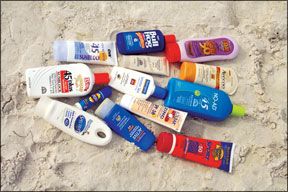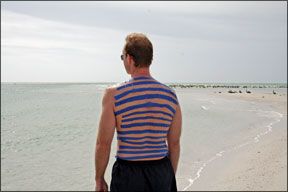In our opinion, the only sunscreens worthy of addressing in a sunblock review are those that offer broad-spectrum protection from sunburn. Formulas that ignore UVA protection and offer only UVB protection are as outdated as George Hamiltons suntan. Most products we tested combine UVA and UVB blockers to offer broad-spectrum sunscreen coverage. Physical blockers—metal oxides such as titanium dioxide and zinc oxide—reflect both UVA and UVB. These offer the best protection and are not chemicals, so theyre less likely to cause irritation to sensitive skin, but they often leave a thick, white residue on the wearers skin. In terms of chemical UV blockers, Parasol 1789 also ranks high in protecting against sun exposure.
For many of us, an annual trip to the dermatologist has become a must. Years spent sailing—with sunlight reflecting off the water and white fiberglass decks—combined with thinning ozone and more intense ultraviolet radiation have sentenced us to a yearly once-over at the docs office. It was just such an experience that sparked this sunscreen test.

One Practical Sailor editor—after being duly reprimanded and ordered to avoid the sun at all cost or else she would surely find her next job singing with the California Raisins—was sent into a panic and pretty much scared into buying a $30, 2.5-ounce tube of sunscreen from the doctors office. Hours later, once the shock wore off, curiosity and frustration set in.
When did sunscreen become so expensive? Does the high-dollar goop, which looks just like the budget goop, protect your skin any better? How are consumers suppose to know which sunscreen protects the best without breaking the bank?
Prices have risen obscenely since Practical Sailor last tested sunscreens (September 2002). In 2002, we determined that if “youre paying more than a buck an ounce for broad-spectrum sunscreen, its too much.” Of the 13 products tested this year, only two (No-Ad SPF 45 and Ocean Potion 50) cost less than a dollar per ounce. The high-end products tested in 2002 cost $2.50 per ounce (Bain de Soleil and Hawaiian Tropic), while this years top-shelf product rings in at an incredible $12 per ounce.
For those dinosaur-thinkers out there who can’t be bothered to use sunscreen, here are some sobering facts from the Skin Cancer Foundation: Skin cancer is the most common cancer in the U.S., and its the No. 1 cancer in men over 50. Take a look around the docks: One in five Americans and one in three Caucasians will develop skin cancer.
UV rays broken down
To find out whether we get more if we spend more, we first must wade through a sea of acronyms and chemical names impossible to pronounce. What follows here is a nuts-n-bolts approach to all things UV.
The sun emits invisible energy in the form of UV radiation. Some wise scientist decided that although the solar spectrum is continuous, it is more convenient to categorize the UV by the wavebands in which it travels, and so he split it into UVA, UVB, and UVC. The longer the wavelength, the less intense the UV.
Ninety-five percent of the radiation that reaches the Earths surface is UVA, which can penetrate the deepest layers of your skin. UVA is to blame for the longterm damage to your skin, such as accelerated skin aging and wrinkles. (Its not the kids that you have to thank for those wrinkles—it is the summers spent hatless, squinting at the horizon.) Contrary to previous thought, studies have shown that UVA likely plays as large a part in skin cancer as UVB, which is a more intense UV. And because UVA is around all year and can penetrate glass and clouds, were exposed to much more of it.
Although there is no “good” or safe UV, UVB is what most often is referred to as “the bad UV.” Its to blame for those painful, blistering sunburns, and it can cause direct damage to the DNA. It can also give you that bronze, summer glow, but according to the Skin Cancer Foundation, a tan is as much a sign of skin damage as sunburn. Accelerated skin aging and cancer also result from UVB exposure. UVB is most intense between 10 a.m. and 4 p.m., April to October, and cannot penetrate glass.
The shortest—and highest energy—of the UV clan is UVC. You don’t hear about it much because it never reaches the earths surface and does not contribute to skin damage.
SPF explained

Sunscreens do not offer total protection, so they are labeled by sun protection factor (SPF) to allow users to gauge their ability to deflect the suns rays. The numbers correspond to how much longer, with proper sunscreen application, a wearer can stay in the sun without getting burned as compared to how long the wearer, without sunscreen, can be in the sun without getting burned. One way to think about it: If, without sunscreen, you normally turn red after 20 minutes in the sun, then an SPF 15 sunscreen will allow you to stay in the sun 300 minutes (20 x 15) without turning red. (Remember that experts recommend you reapply every two hours, regardless of the SPF used.)
The American Cancer Society offers this example: When using an SPF 15, you “get the equivalent of 1 minute of UVB rays for each 15 minutes you spend in the sun. So, two hours in the sun wearing SPF 15 sunscreen is the same as spending eight minutes totally unprotected.”
And don’t be misled, an SPF 30 sunscreen is not twice as strong as an SPF 15. SPF 30s deflect about 97 percent of the suns rays, while SPF 15s block 93 percent.
Also important to remember is that the SPF number indicates protection from UVB rays only. There is no measuring stick for UVA protection. So we recommend choosing a sunscreen that offers broad-spectrum protection (blocks UVA and UVB) not just a high SPF. Both the SCF and AAD suggest using a minimum of SPF 15.
Science of sunscreens
In our opinion, the only sunscreens worthy of addressing are those that offer broad-spectrum protection. Formulas that offer only UVB protection are as outdated as George Hamiltons tan.
The chart on page 30 shows which active ingredients the U.S. Food and Drug Administration has approved as UVA and/or UVB blockers. Most products combine UVA and UVB blockers to offer broad-spectrum coverage. Physical blockers—metal oxides such as titanium dioxide and zinc oxide—reflect both UVA and UVB. These offer the best protection and are not chemicals, so theyre less likely to cause irritation to sensitive skin, but they often leave a thick, white residue on the wearers skin.
Each ingredient has its benefits, but rather than getting bogged down in all the science, we suggest you look for sunscreens that list as active ingredients avobenzone (also called Parsol 1789), titanium dioxide, or zinc oxide.
Let experts guide you
There are several organizations that aim to make it easier for buyers to navigate the sunscreen maze. The Skin Cancer Foundation and the American Academy of Dermatology both have certification programs for sunscreens. In order to garner SCFs or AADs recognition, a product must meet strict criteria as established by each organization. Products that make the cut can display the SCF or AAD seal on their packaging.
To carry the SCF “Recommended” logo, a product must have an SPF of 15 or greater; validation of the SPF through testing; and proof that the formula does not cause irritation. Each product that carries the SCF logo is monitored annually to be sure it continues to meet the criteria. The SCF lists all logo-carrying products—not just sunscreens—on its website, www.skincancer.org.
The AADs newly established program allows manufacturers to display its “Seal of Recognition” on a product once they provide documentation that it is broad-spectrum, water-resistant, doesn’t cause skin irritation, has an SPF of 15 or higher, and has met all FDA standards.
Its a similar idea to those “certified organic” stickers they put on produce these days. Instead of fretting over chemical names and product formulas in your search for a quality sunscreen, simply look for the SCF or AAD seal on the product packaging and compare prices.
The AAD website, www.aad.org, offers a host of resources for consumers. If you don’t have a dermatologist or don’t have the cash to spend on an exam, check out the AADs locator map of doctors across the U.S. who offer free skin screenings. Youll also find tips for doing self checks.
The Practical Sailor evaluation
Keenly aware that it is impossible to evaluate all sunscreens available in the U.S., testers picked up an array of products at a local pharmacy. Added to that roster are two products from a local dermatologists office. Only products with an SPF of 30 or better were included.
The 13 sunscreens that made the lineup were: Aveeno Active Naturals Continuous Protection 45, Banana Boat Sport Ultra Sweat-Proof 50, Bull Frog Superblock 45 (Amphibious Formula), Coppertone Spectra 3 Triple Protection 50, Coppertone Sports Stick 30, CVS Clear Sheer 45, Hawaiian Tropic All-day Waterproof Sheer-Touch 45, M.D. Forte Environmental Protection Cream 30, Neutrogena Active Breathable Sunblock 45, Neutrogena Sensitive Skin 30, No-Ad Maximum UVA/UVB 45, Ocean Potion Broad Spectrum 50, and Solbar Zinc 38.
As a test platform, we chose the most fair-skinned editor among us. We taped his back into horizontal stripes using masking tape. Between each stripe, liberal amounts of a product were rubbed in. We let the sunscreens “set” for about a half-hour before removing the masking tape. Under the mid-day Florida sun, with partly cloudy skies, the striped tester lay on the beach for two hours without re-applying. At the two-hour mark, he went for a dip in the Gulf of Mexico to see how much product residue would remain. We gauged each products application, consistency, smell, coating (residue), longevity, performance, and cost.
Results
Six products—Solbar Zinc, Coppertone Spectra 3, No-Ad, Bull Frog, M.D. Forte, and Neutrogena Sensitive Skin—went on much heavier than the others, requiring much effort to rub in. Even after two hours of sun exposure and our testers quick dip in the ocean, these products still showed their thick, white residue.
Performance-wise, the products did not vary greatly—at least not to the naked eye. The Hawaiian Tropic and Aveeno sections appeared a bit more pink than the others, but not enough to draw definite conclusions on performance.
Conclusions
Through research and testing, reviewers determined that a quality sunscreen must be waterproof and must offer broad-spectrum protection. The test products that fit the bill—and our price range—were Practical Sailor Best Choice Coppertone Spectra 3 and Practical Sailor Budget Buy No-Ad 45. Testers also liked the Banana Boat, Bull Frog, and CVS products, which we recommend. The Neutrogena Active Breathable and Solbar Zinc also ranked high, but they were out of our pricing comfort zone. For those with sensitive skin, we recommend Sol-Bar Zinc. Its more expensive than Neutrogena Sensitive Skin, but it has the benefit of being water-resistant.
The No-Ad, our Budget Buy, lists the same active ingredients as the Neutrogena Active but costs $1.40 less per ounce. The same is true of the CVS product. So the moral of the story here is: When it comes to selecting an effective sunscreen, more money doesn’t get you better protection.
When youre faced with row after row of sunscreens, first look for products that carry the SCF or AAD seals, then narrow your choices by comparing prices. If you have sensitive skin, look for chemical-free formulas with metal oxides and Parsol 1789.
We spend countless hours—and dollars—protecting our boat from “harsh marine conditions,” so it only makes sense that we give ourselves the same attention.


































